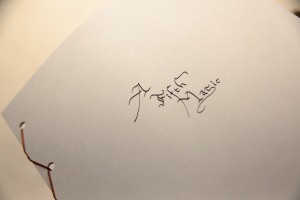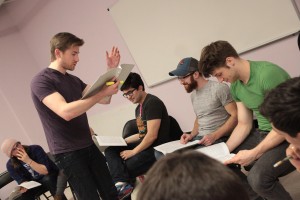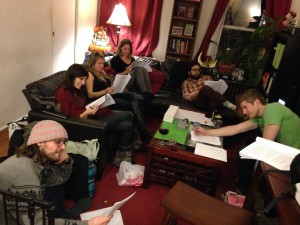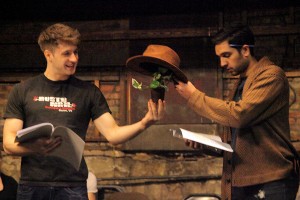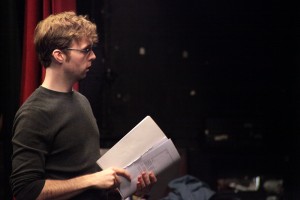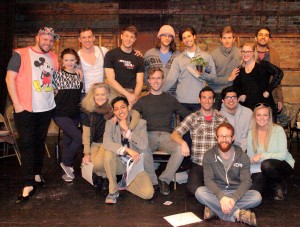When Carol Mertz-Eischeid of Bishop Garrigan Schools, in Iowa, first asked me about writing a play for them, I knew right away that that would entail a certain number of steps. The two most important (and the two most difficult) were: 1) write a script, and 2) produce a reading.
Writing a script is the obvious part. And, for the purposes of this post, we’ll leave it alone for now.
Producing a reading is the trick, though.
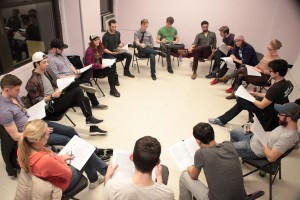
The cast at Ripley Grier Studios in New York City for our first proper read-through (one actor per part). Nathan Fremuth substituted for Anna Michaels as “Grandma.”
Purpose of a Reading
The advice to any writer is as old as writing itself: “Read it out loud.” This editorial strategy is surprisingly effective for the simple reason that language is first and foremost a spoken enterprise.
The speech center of the human brain is one of the few anatomical differences between our species and every other – including chimps, dolphins, cats, whales and bonobos. We have so much in common with all the various types of life on this planet, yet NONE of them can speak. They are physically missing the part of the brain that handles that.
(It’s the author’s personal theory that this alone is primarily responsible for our domination of the Earth.)
Even in humans, if that part is not accessed in time, it will shut down, and a person will become forever unable to learn a human language. At all.
Writing, on the other hand, is an entirely artificial construction which human beings painstakingly manufactured, collectively, over the course of millennia to suit their spoken language. That’s why it’s no trouble at all for a baby to learn Mandarin, but fully-grown adults are in a life-or-death struggle between there, their, and they’re.
Speech your brain handles; we could say it’s “natural.” Writing is unnatural – it’s purely man-made, and therefore really, really convoluted (just like your iTunes service agreement!).
After a writer has spent hours pouring over a project, unless they’re unrealistically lucky, some of that “writerly” convolution will have crept into what they’ve done. When they read over it, it appears perfectly fine. But only when it’s read aloud does the subtle truth come out.
If you think about it, you’ll notice a very big difference between what we write and what we say.
“What is up?”
vs.
“Sup?”
That’s what makes writing good dialogue such a challenge. Because you’re really dealing with two separate languages with distinct rules and conventions. (German, in fact, has confronted this reality so well that written German has totally different rules from spoken German.)
Speaking the words out loud forces you to deal with those differences. And the edits you make afterward reconcile them so that what you get in the end will sound more like something real people would actually say. That means audiences hearing it for the first time will be able to understand it without effort, which is of course crucial.
Producing a Reading
Now comes the hard part. For a play, you need actors to read as characters. Ideally, you have an individual actor on each part. You’ll also need an extra voice just to read stage directions to make it clear what physical business is going on. You, the author, should just sit quietly and listen.
In the case of “A Fifth Magic,” I first assembled a small team to read through the script in a circle. We didn’t have enough bodies for all the parts, so we read cyclically – actors read one line at a time going clockwise, so that each time a person read, they were a new character. This was great fun, and looked like this:
Though this was not given to a proper audience, this was still a reading. And it served to knock a lot of the kinks out of awkward phrasing and uncovered several typos. It also gave me my first glimpse into how the show might be received by people outside myself. But it didn’t help us discover impossible costume changes, prop redundancies, ineffective blocking, or sight-gag problems. For that type of analysis, you have to go a step further.
To get a really close look at all the details involved in an entire play, you have to recreate as many of those details as possible. In my case, a full-scale production was unfeasible, however it would have offered the best trial, as inevitably every issue that could come up would come up, and we’d have found ways to address them.
The next best thing is a staged reading.
Some plays don’t use any props. Some don’t care how the actors are dressed. Some plays need super-specific set pieces, or special effects. Plays are endlessly different in their technical requirements. This particular show is rather prop-heavy and highly visually oriented. As a result, to get any sense of how all those props would actually function together, I had to put objects into the hands of the actors to see how they worked. And to know if my sight-gags and visual jokes were going to be funny at all, we had to actually see them. (Spoiler alert: they’re hilarious!)
I wrote into this show a few magical illusions that need specialized props. There’s a “Magic Blanket” and a “Magic Tophat” that we had to actually construct. There was originally a magically levitating book prop that was eventually cut from the show.
Here’s the book in action!
Pretty cool, huh?
I cut it for one ultimate reason, but there were several others. The real reason was that there was a sweeter/better way to handle what the levitating book was trying to do within the story. The best secondary reason was that it was really, really technically demanding to perform. You needed perfect lighting, specific stage dressing, multiple people well-coordinated to work together, and a decent amount of construction to even have a prayer of having it come out right, and even then it wasn’t particularly robust. We didn’t have nearly enough rehearsal time available to make that work, and we didn’t have enough control over the theatre’s lights.
But the show is better off without it, and all those reasons above are partly why.
This coming Monday night will be the final test. I get to sit back in a darkened theatre and watch all my collected thoughts be transferred into the bodies and minds of 16 incredibly talented people. At that point I will be entirely removed from the process, and what I witness will therefore offer me the most information possible. I’ll get a picture of what happens when real people go running wild with nothing more than words I wrote down in a certain order.
And that, folks, is what it’s all about.
– Photography by Laura McBride –
